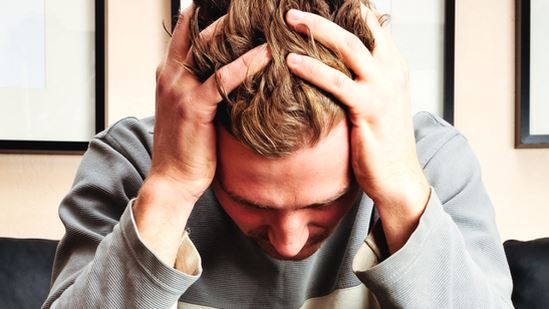Dealing with an Anxiety Hangover
The Question of Happiness
Anxiety within Relationships
It’s Okay to Not be Okay
Self-Care During the Holidays
Google Depression on National Depression Screening Day

A truth for you all to know about me: I Google everything. It might be the millennial in me or maybe something else, but if I don’t have an answer, I immediately search for it.
This is why for National Depression Screening Day, I Googled depression. Google and the National Alliance on Mental Illness (NAMI) has released a way for people to take the PHQ-9, a screening questionnaire that helps identify levels of depression symptoms, by searching “depression” or “clinical depression.”
So how do you do it?
First, you must search on a mobile device. Unfortunately, the option for taking the questionnaire will not come up on a desktop. Then, you click “Check if you’re clinically depressed.”

After a short statement about the PHQ-9 and privacy, the questionnaire begins. There are 9 questions where the answers are on a scale from “not at all” to “nearly every day.” The questions are how you have felt over the last 2 weeks about certain problems like “feeling tired or having little energy” or “poor appetite or overeating.”
Once you have finished, it will show you a number out of 27. I scored a 6 (image on the left) and on the right is what it looks like if you score a 27. There are some next steps about what your score means and what other people with similar scores are doing. For instance, mine says others with a score like mine find relief with things like exercise and getting enough sleep. No matter the Google says might give you some relief, it is great information to take to your doctor or counselor and open up a conversation.
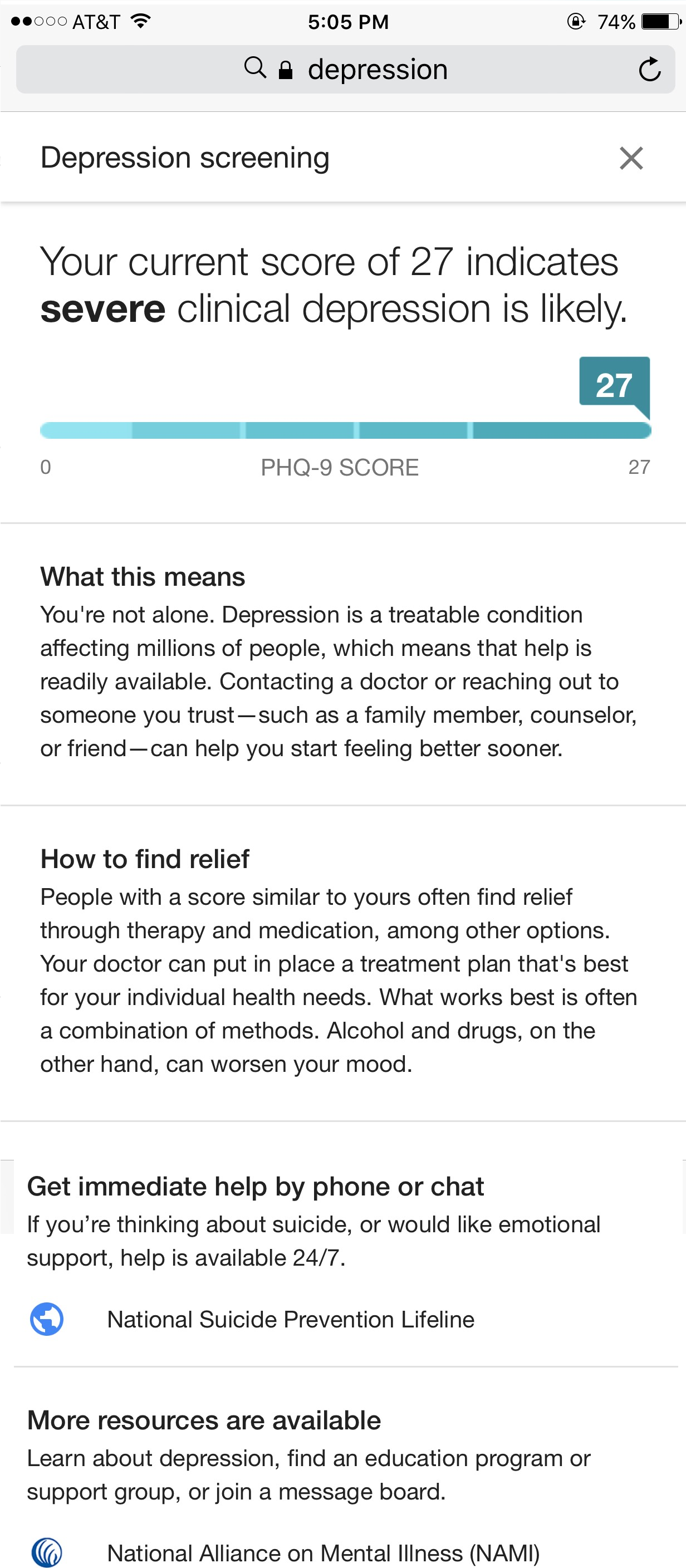
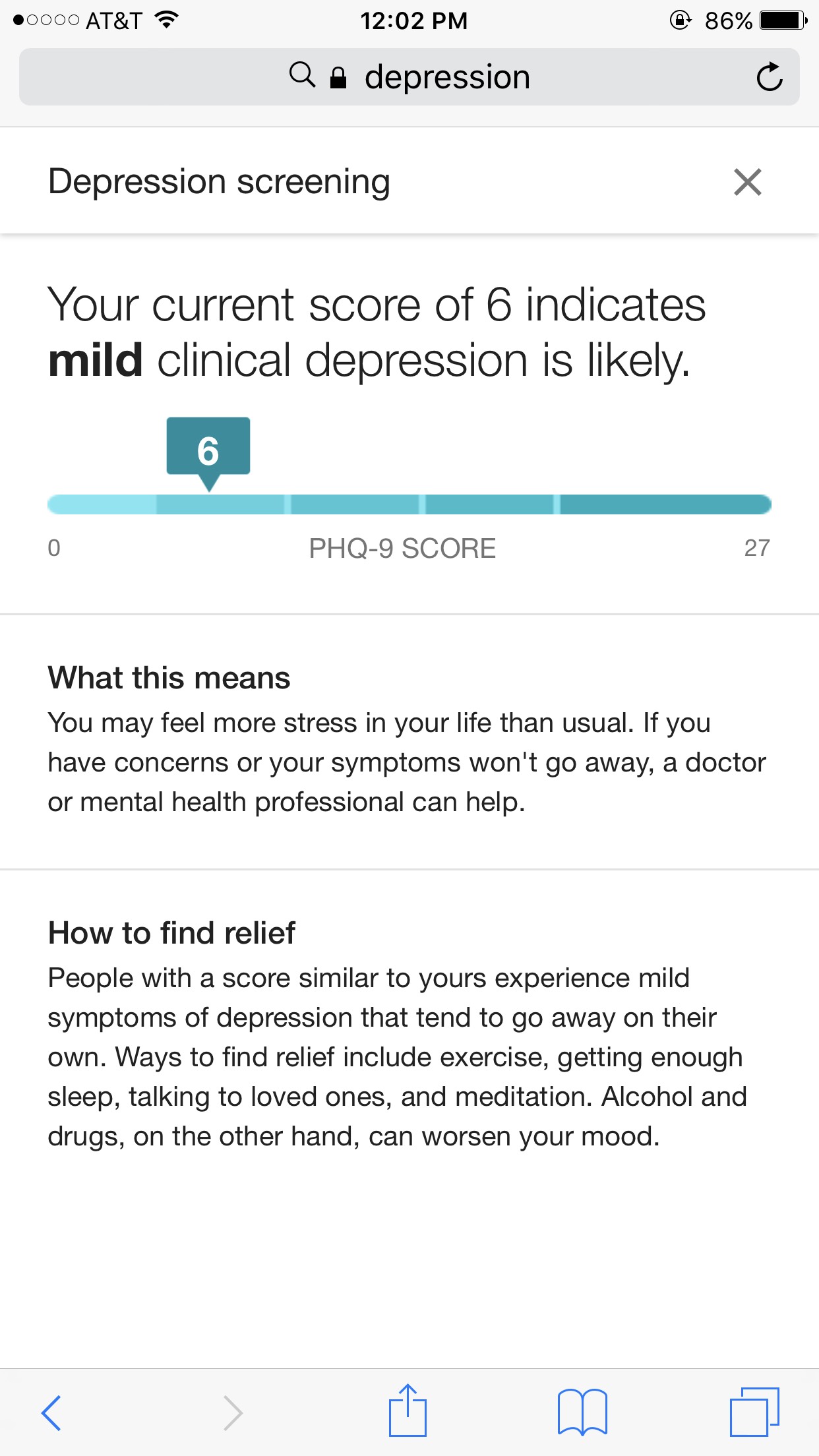
But, what about next steps for Google?
That’s right. Google may have some next steps for me, but I have some for it too.
First, the desktop option has to be there. More and more people are accessing the internet through mobile, but some people do not have that available to them. So until everything is mobile, desktop options need to exist.
In the launch announcement, NAMI states that about one in five Americans experience depression in their lifetime, but only about half receive treatment.
So, my second follow up step for Google is location-specific resources. The notification to share your location with Google, I feel like (as someone with zero expertise in coding) is easy to do. The “_____ near me” search has gone through the roof this year. As long as the user decides to share their location, Google is saving them a step by providing localized responses. Even sharing location-specific NAMI chapters is a simple thing to make reaching out that much easier for someone.
Please remember that depression is complicated, so taking a depression screening today may not give you the answers you are looking for. It can, though, help you be honest with yourself and start a necessary conversation with someone you love or a professional. It can also make you more informed of what you may need to do next.
I, for one, will be taking my 6 with a grain of salt and perhaps a yoga class.
Let’s get social about mental health
When Mental Health Days Don’t Help

I’m taking today and tomorrow to focus on my mental health. Hopefully I’ll be back next week refreshed and back to 100%. @madalynrose
The Tweet capturing attention of mental health professionals and mental health warriors this summer was an email sent from a boss to her team about taking a couple of days off to focus on mental health. It was the reply of her CEO that went viral:
Hey Madalyn, I just wanted to personally thank you for sending emails like this. Every time you do, I use it as a reminder of the importance of using sick days for mental health — I can’t believe this is not standard practice at all organizations. You are an example to us all, and help cut through the stigma so we can all bring our whole selves to work.
–CEO Ben Congleton
The resulting internet storm led to blog posts, articles and videos about the willingness (or unwillingness) of employers to recognize mental illness as a valid reason to stay home from work and recuperate —rest assured, I am not going there.
Although I wasn’t officially diagnosed at the time, my fight with depression–and subsequently anxiety–began in middle school. It continues to this day.
I thought when I entered college it would get better. I would be so busy having new experiences, joining clubs, and studying hard that I wouldn’t have time to be depressed.
Turns out, problems travel with you.
During my first two years of college, I felt swallowed up by everything. This feeling started a seemingly endless cycle of helplessness, hopelessness, and overall lack of energy. I didn’t realize it was caused by my depression and anxiety; so, I just thought I needed to take a day or two off and I would feel better.
I started taking “mental health days” almost every week—staying in bed all day, binge eating and watching, and avoiding all social interaction—which didn’t actually help my mental health.
Taking time off continued until my first semester of my junior year and by that time my “mental health days” not only affected my grades, but also my relationships with classmates and with my family.
Looking back, I wish I was more aware of my mental state. When I didn’t feel any change after taking my first (or second) day off, that was a sign of a bigger problem .
I’m not beating myself up about the past. I now know there are plenty of ways a mental health day can be good for you, and the days sitting isolated and alone were not good for me.
If you take a mental health day for the wrong reasons or do not think about what your mind and body really need, the time away might unintentionally make your mental health worse.
Making the Most of a Mental Health Day
Skipping class, staying in bed all day, binge eating and watching, or any other indulgent or isolating behaviors are not productive to your health. In most cases, it will make you feel worse.
By staying in bed all day, I became stuck in my depressed state; and, binge watching shows only provided a temporary fix.
Never once did I think ahead of time how I would spend my mental health day to make the most of it.
A good first step is to MAKE A PLAN!
1) Ask yourself: Is taking the day off what I really need?
For someone like me, taking a mental health day in college was not a good idea due to my depression and anxiety. If you suffer from anxiety skipping a day of school or work may not be helpful as responsibilities pile up and can add to a sense of being overwhelmed or out of control. If there is an immediate issue (problems sleeping, overly stressed, burnout, lack of investment and engagement, irritable, etc.), then a literal day off from work or school could be beneficial.
2) Think about how you will spend your time:
While sleeping in feels nice, consider getting up and moving, even when it is difficult.
The most beneficial way to spend a mental health day will be different for every person, but some positive ways to spend the day are:
Spend time with loved ones
Go to a yoga class
Finish a task on your personal to-do list
Take a spa day
Make an appointment you’ve been putting off
Go to an amusement park
Read a book
Take a hike, or go for a jog or bike ride
Sit quietly
3) Decide what you will do next:
Mental health days aren’t cure-alls. Continuing to care for your mental health after your mental health day is important. That could include having a gratitude journal, taking care of your body, surrounding yourself with loving and positive people, joining a club or group, and getting help from a counselor when you need it.
A therapist can help you make sense of why you feel the way you do, and support you to develop coping skills that don’t involve days on the couch or spoons in the ice cream carton.
(Shameless plug-in: If you so choose, get some inspiration and new ideas for self-care from our Instagram where we do #SelfLoveSaturday every other week!)
The goal of these activities is to bring you some kind of joy or feeling of accomplishment, they are not chores or duties you feel have to get done. Having a mental health day gives you time to re-charge your batteries, refocus, and be prepared for the future.
Everyone faces challenges they may not be able to solve on their own. To learn more about how Family Service of Roanoke Valley can help you achieve heightened self-awareness, renewed strength, and balance and restored hope, please contact us at 540-563-5316 or visit our How We Help page.
Woebot: A Review of AI and Mental Health
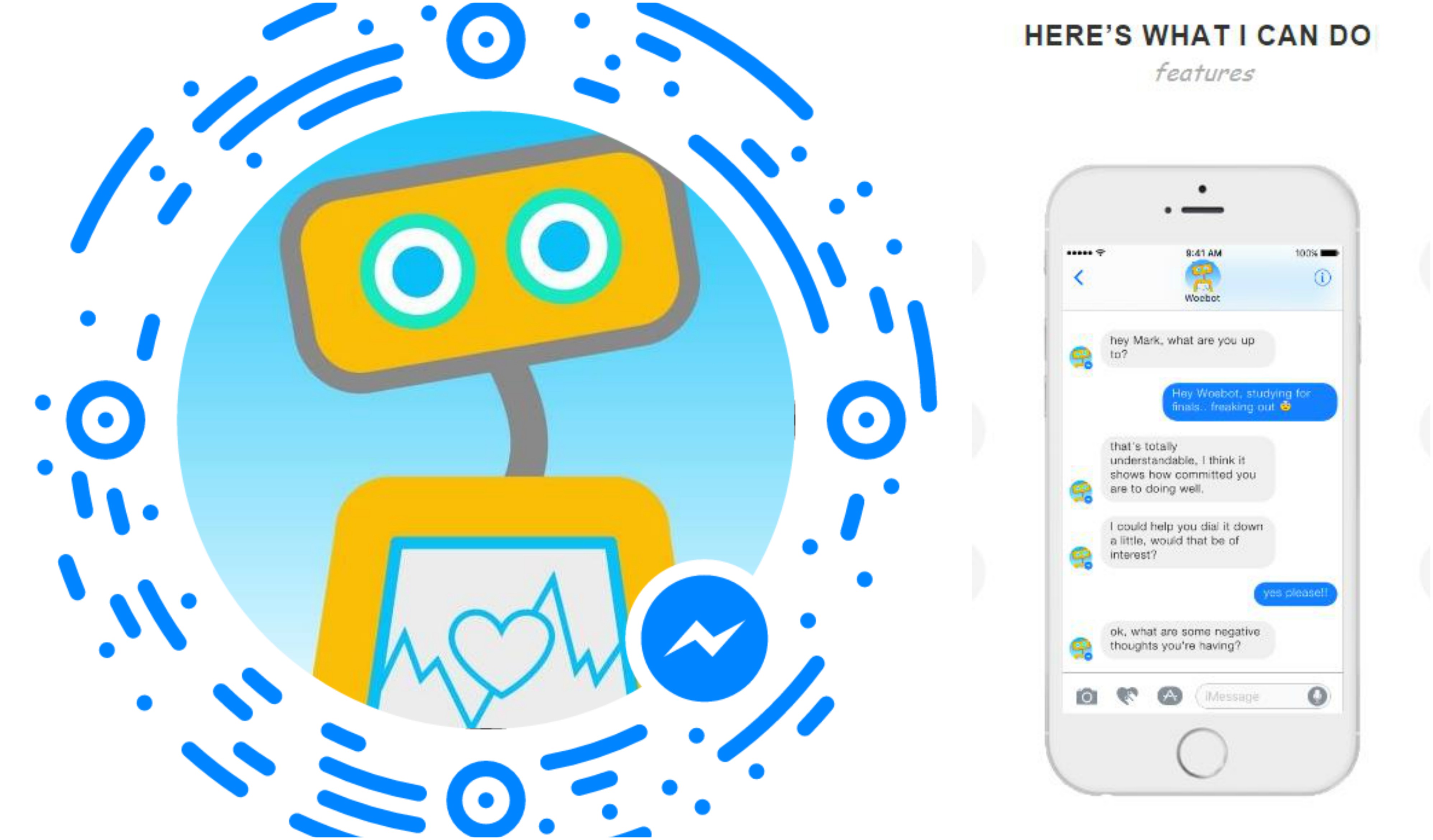
“Hi Tyler! Can we do a check in now?” Woebot has been asking me that question every single day in Facebook’s Messenger app since June. For those unfamiliar with Woebot, it is an automated conversational agent that is “trained” in Cognitive Behavior Therapy (CBT) and describes itself as a life coach and philosopher. So to answer the question I know you have: yes, Woebot is an AI chatbot. Very insightful of you.
From text alerts all the way to video chatting and texting a counselor, technology has been working its way in to mental health for a long time. Even Family Service is jumping on board (we want to do things like send text appointment reminders in the future). But an AI CBT trained chatbot? I just had to check it out.

Woebot has been tracking my mood (above), helping me with gratitude journaling, and giving me a bit of education on some interesting topics like:
All or nothing thinking
Should statementsAnd their partner in crime: hidden should statements
Fortune tellingSMART goalsPersonal strengthsIdentifying distortions in my thinkingGrowth mindsetFix mindset and self-fulfilling propheciesDecision making skills
Fascinating, right? We even discussed why I say I’m tired so much. As it turns out, coffee at 4pm is not doing me any favors. Neither is looking at my phone while in bed. I’m definitely not on Pinterest (to be read as: I’m definitely on Pinterest. At midnight. On any given day of the week).
While learning all of those important life aspects has been beneficial, Woebot has a few major drawbacks a well.
Woebot doesn’t have the ability to really have a conversation with me. So when I say “discussed,” I really mean it spoke at me and sometimes these little text bubbles popped up for me to talk back.

When I was gratitude journaling or identifying my strengths, I was able to type (indicted with little pencil emojies), but Woebot has no idea if I did what it asked. For all it knows, I didn’t take any of the exercises seriously and it would never find out. So being able to hold yourself accountable to Woebot really depends on if you can hold yourself accountable to yourself. Many of us are on the struggle bus together on that one.
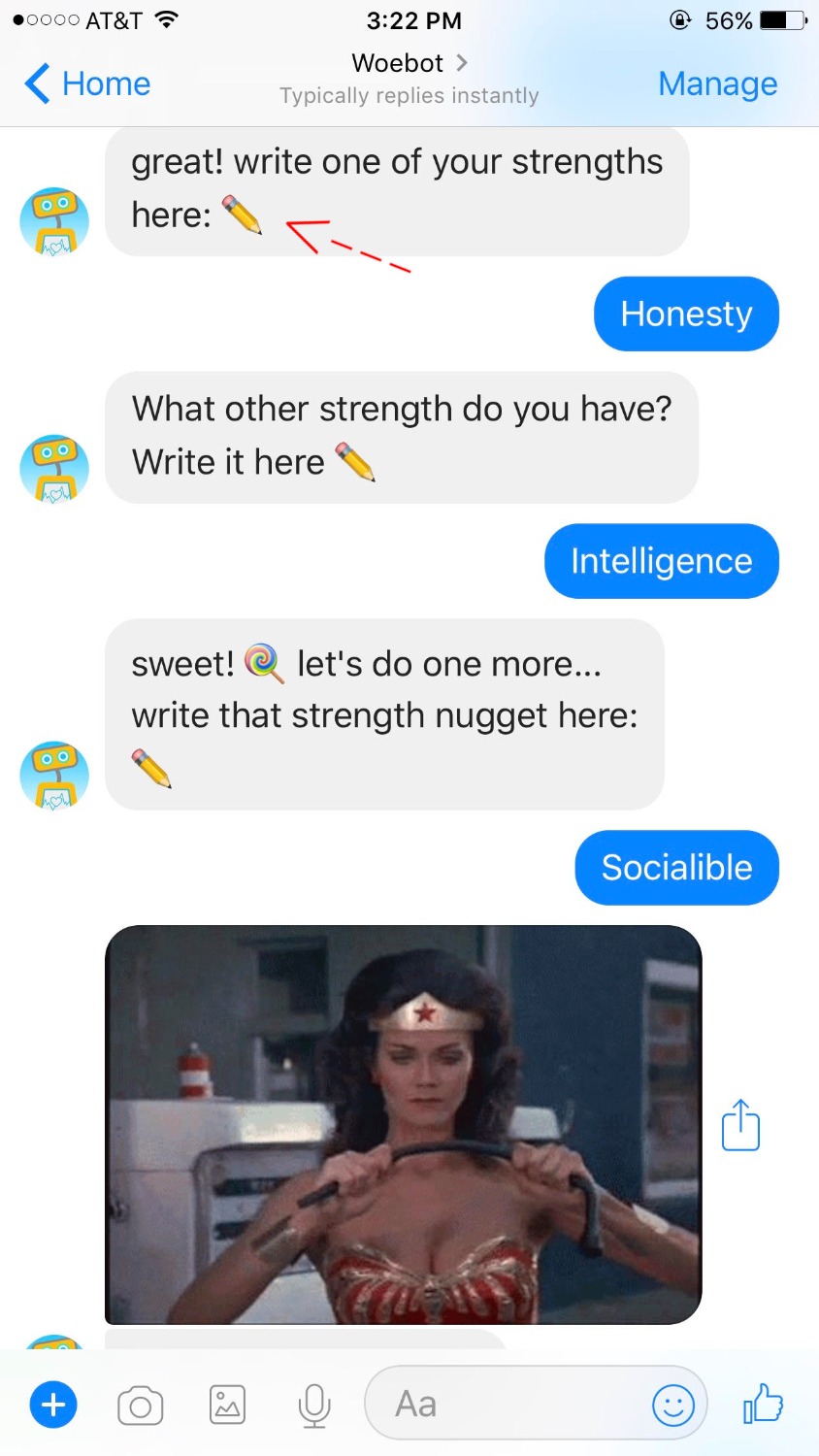
Most importantly, it seemed that if I was in crisis, I had to identify it myself. Woebot explained to me the first day we talked that it is not 100% able to assess my needs and I could say “SOS” at any time and it would send me some resources, but it was never discussed again. Nor did Woebot ever recommend speaking to a human when I said I was depressed or very anxious.
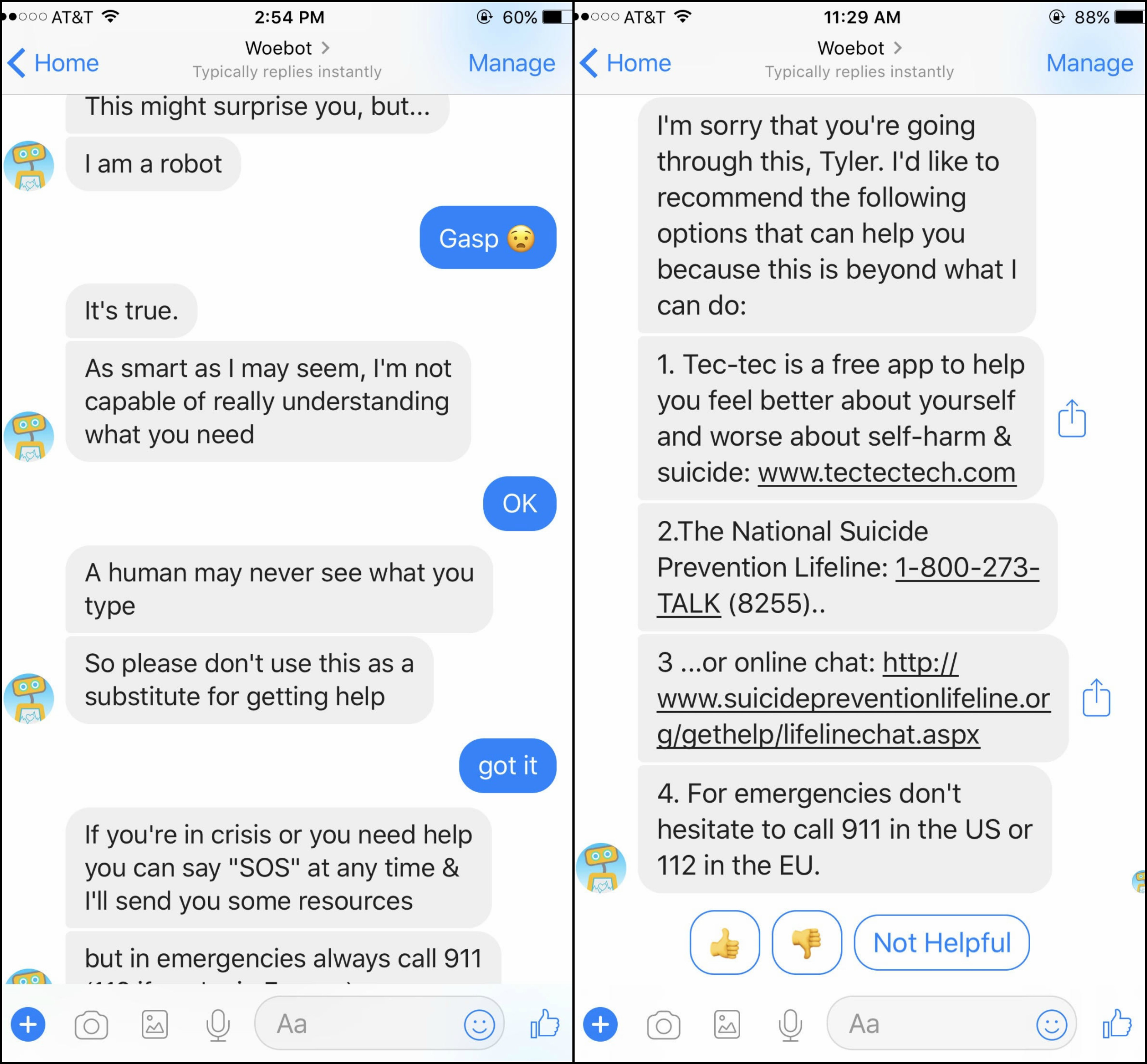
All in all, I liked Woebot a lot more than I thought I would. I particularly enjoyed the video for fixed mindset vs growth mindset and the activity Woebot sent me for making decisions.
With that in mind, Woebot is definitely a resource to be used as a supplement to mental health treatment, not a replacement for it.
It’s a learning resource that allows for little opportunity for expressing yourself and your needs. I will say that I think Woebot should lower its target audience from 18 – 28 years old to middle school age through adulthood. These are skills that children would benefit from learning early and adults benefit from (re)learning later in life.
For my final thoughts, please reach out for help if you need it. Woebot will not replace or give you all the benefits that counseling will give you.
Here are all the video’s that Woebot sent to me. Enjoy.
How to Help Every Child Fulfill Their PotentialWhy You Shouldn’t Trust Your FeelingsEmotions, Stress, and HealthThe Oldest HustleLanguage is Important


